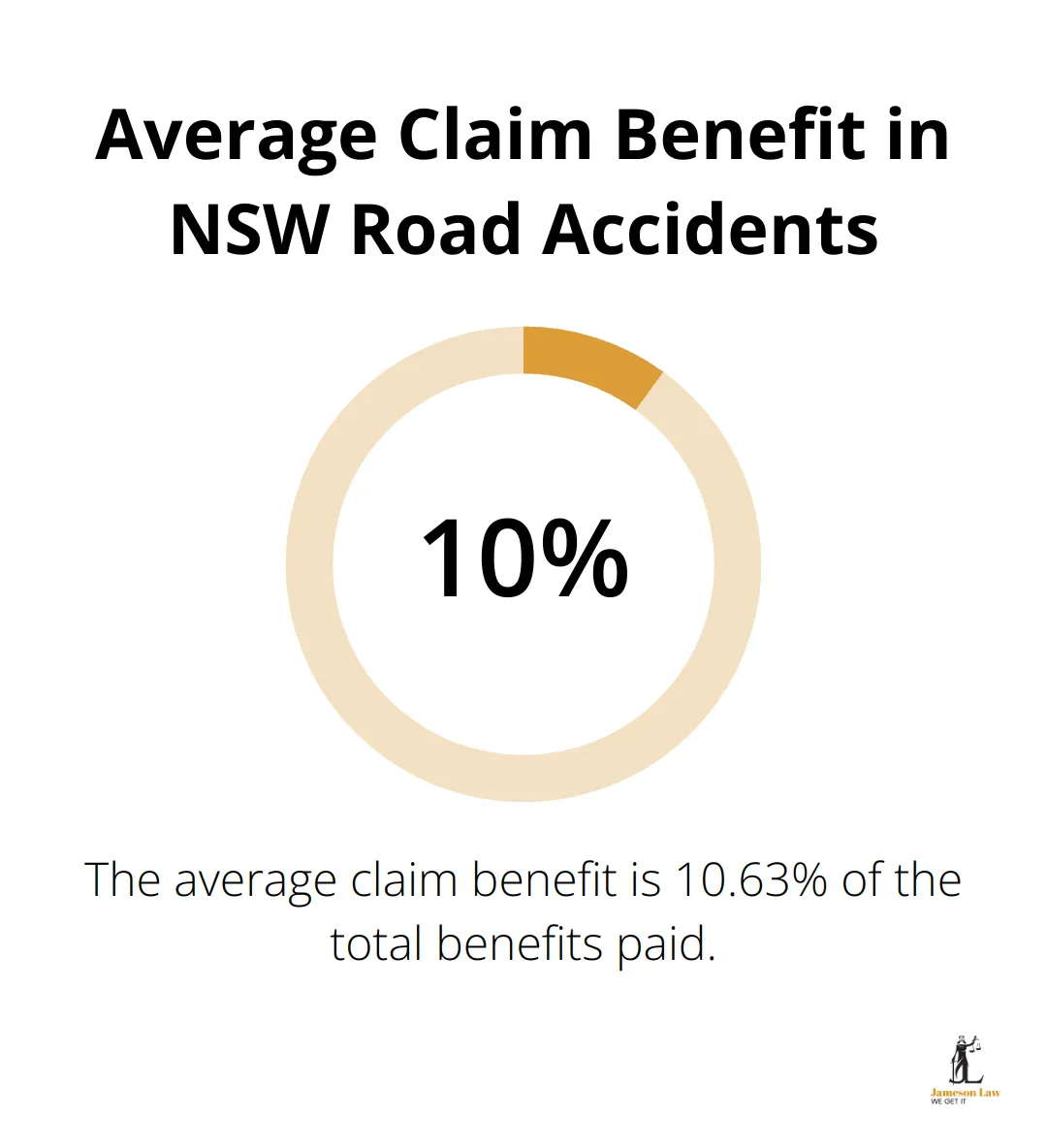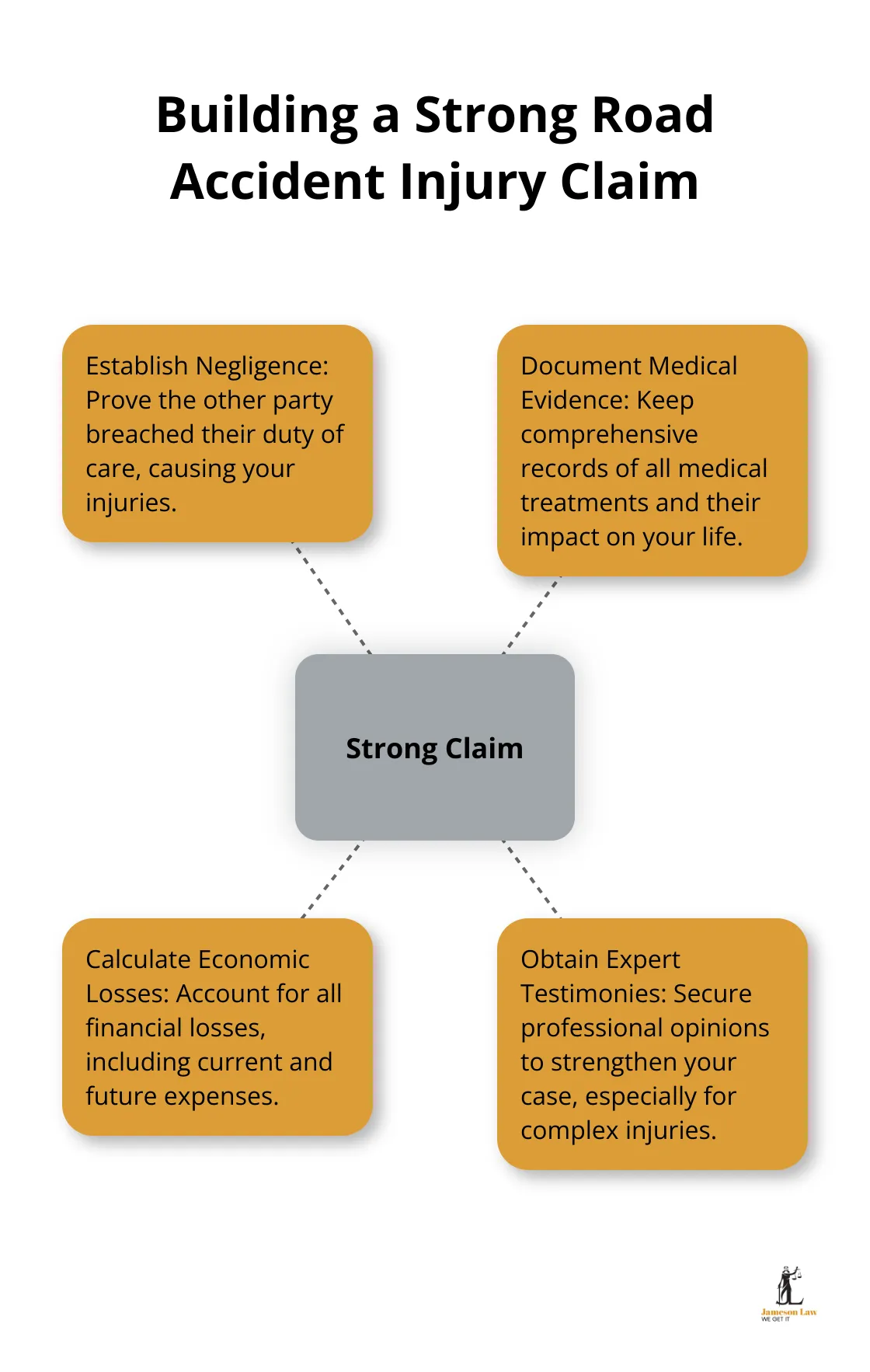Road accidents can turn lives upside down in an instant. Navigating the complex process of filing road accident injury claims can be overwhelming for victims.
At Jameson Law, we understand the challenges you face and are here to guide you through every step. This post will provide you with essential information and practical tips to help you file your claim successfully.

What to Do Right After a Road Accident
Prioritise Safety and Health
Your first priority after a road accident is safety. Move to a safe area if possible, and check yourself and others for injuries. Call NSW SES on 132 500 for emergency assistance during a flood, storm or tsunami. Even if injuries seem minor, it’s smart to get checked by a medical professional. Some injuries (like whiplash or internal bleeding) may not be immediately apparent.
Document the Scene
Once you’re safe, start gathering evidence. Use your phone to take photos of the accident scene, including all vehicles involved, licence plates, and any visible injuries. Make notes about the accident while your memory is fresh. Include details like the time, date, weather conditions, and your recollection of how the accident occurred.
Report the Accident
In New South Wales, you must report any accident to the police within 28 days for your claim to be valid. For major incidents (involving injury, intoxication, or hazardous conditions), call the police immediately. Their report will play a key role in your claims process.
Collect Essential Information
Get essential information from the other driver, including their name, contact details, driver’s licence number, car registration, and insurance details. If there are witnesses, ask for their contact information too. This information will prove invaluable when you file your claim.
Seek Legal Advice
The actions you take immediately after an accident can significantly impact your injury claim. If you’re unsure about any aspect of the process, don’t hesitate to seek legal advice. Personal injury lawyers can assist you in securing compensation after accidents or injuries effectively.
As we move forward, let’s explore the types of compensation available for road accident injury claims in NSW and the important time limits you need to be aware of.
Understanding Road Accident Injury Claims in NSW
Types of Compensation Available
The Compulsory Third Party (CTP) scheme in NSW provides coverage for all parties involved in motor vehicle accidents. This includes drivers, pedestrians, cyclists, and riders. You can claim compensation for both economic and non-economic losses in NSW.
Economic losses encompass lost wages and medical expenses. For the initial 13 weeks post-accident, you may receive up to 95% of your pre-accident earnings. This amount reduces to 80-85% after this period.
Non-economic losses (often called pain and suffering compensation) apply if your permanent impairment exceeds 10%. This compensation addresses the impact of injuries on your quality of life.
Time Limits for Filing Claims
Swift action is essential for road accident injury claims. NSW law requires you to report any accident to the police within 28 days to maintain claim validity. For weekly benefits, you must lodge claims within 28 days. The final lodgement deadline is 3 months, barring extenuating circumstances.
The Role of SIRA
The State Insurance Regulatory Authority (SIRA) oversees the CTP scheme in NSW. SIRA’s responsibilities include:
- Setting guidelines for insurers
- Monitoring insurer performance
- Providing dispute resolution services
SIRA data reveals that during the 12 months to August 2022, NSW recorded 9,408 motor accident injury claims. The total benefits paid amounted to $865 million, with an average of $91,943 per claim.

No-Fault vs At-Fault Claims
NSW operates a hybrid CTP scheme. For the first six months post-accident, benefits are provided on a no-fault basis. This means you can receive compensation regardless of who caused the accident. After this period, the at-fault system takes effect, where your compensation depends on proving another party’s negligence.
Seeking Legal Assistance
Navigating the complexities of road accident injury claims can prove challenging. Professional legal guidance can help you understand your rights, meet deadlines, and maximise your compensation. While many law firms offer services in this area, Jameson Law stands out with its expertise in personal injury cases and commitment to client success.
As we move forward, we will explore the key elements that contribute to a successful road accident injury claim, including how to prove negligence and document your injuries effectively.
How to Build a Strong Road Accident Injury Claim
Establish Negligence and Liability
The foundation of any road accident injury claim is to prove negligence. This involves demonstrating that the other party breached their duty of care, directly causing your injuries. To establish negligence:
- Collect all available evidence from the accident scene (photos, videos, and witness statements).
- Obtain the police report, which often contains key details about the incident.
- Consider traffic camera footage or dashcam recordings if available.
- Keep a detailed account of the events leading up to, during, and after the accident.
NSW operates under a modified comparative negligence system. This means your compensation may reduce if you’re found partially at fault. It’s important to present a clear, factual account of the accident to minimise any potential reduction in your claim.
Document Medical Evidence Comprehensively
Your medical records serve as the backbone of your injury claim. They provide concrete evidence of the extent of your injuries and the treatment required. To ensure thorough documentation:
- Seek immediate medical attention, even for seemingly minor injuries.
- Attend all follow-up appointments and adhere to your treatment plan.
- Keep a detailed journal of your symptoms, pain levels, and how the injuries affect your daily life.
- Request copies of all medical reports, test results, and treatment plans.
- Maintain a file of all medical bills and receipts related to your injury.
Comprehensive medical documentation plays a crucial role in determining fault and compensation entitlement in personal injury claims.
Calculate Economic Losses Accurately
Your claim should account for all financial losses resulting from the accident, including both current and future expenses. This encompasses:
- Lost wages: Document all time missed from work due to injuries or medical appointments.
- Reduced earning capacity: If your injuries affect your ability to work in the future, factor this into your claim.
- Medical expenses: Include all costs related to your treatment, rehabilitation, and any necessary medical equipment.
- Property damage: While separate from personal injury claims, don’t forget to account for vehicle repair or replacement costs.
For an accurate calculation, gather pay stubs, tax returns, and employment records. If you’re self-employed, you may need additional documentation to prove loss of income.
Obtain Expert Testimonies and Professional Opinions
Expert opinions can significantly strengthen your claim, especially in cases involving severe or complex injuries. Expert witnesses provide specialised knowledge and testimony that help establish the facts of the case. They analyse post-accident data and offer insights on:
- Medical expert testimonies: These can provide detailed insights into the long-term impacts of your injuries.
- Occupational expert opinions: These professionals can assess how your injuries might affect your future earning capacity.
- Accident reconstruction experts: In cases where liability is disputed, these experts can provide a scientific analysis of how the accident occurred.
While expert testimonies can be costly, they often prove invaluable in securing fair compensation, particularly for serious injuries or disputed claims.
Building a strong road accident injury claim requires meticulous attention to detail and a comprehensive understanding of the legal process. The complexities involved often benefit from professional legal guidance. If you’re considering legal representation, Jameson Law specialises in navigating these intricate cases (ensuring our clients receive the maximum compensation they deserve).

Final Thoughts
Filing successful road accident injury claims requires swift action and thorough documentation. You must prioritise safety, seek medical attention, and report the incident to the police within the required timeframe. Understanding the types of compensation available under the NSW CTP scheme empowers you to pursue the full range of benefits you deserve.
A strong case involves establishing negligence, documenting medical evidence, and calculating economic losses accurately. Expert testimonies can provide valuable support for your claim (especially in complex cases). The actions you take after a road accident will significantly impact your claim’s success.
Professional legal advice can make a substantial difference in navigating this challenging process. At Jameson Law, we offer expert guidance tailored to your specific situation when handling road accident injury claims. Our team strives to maximise your compensation and help you navigate the complexities of the legal system effectively.













